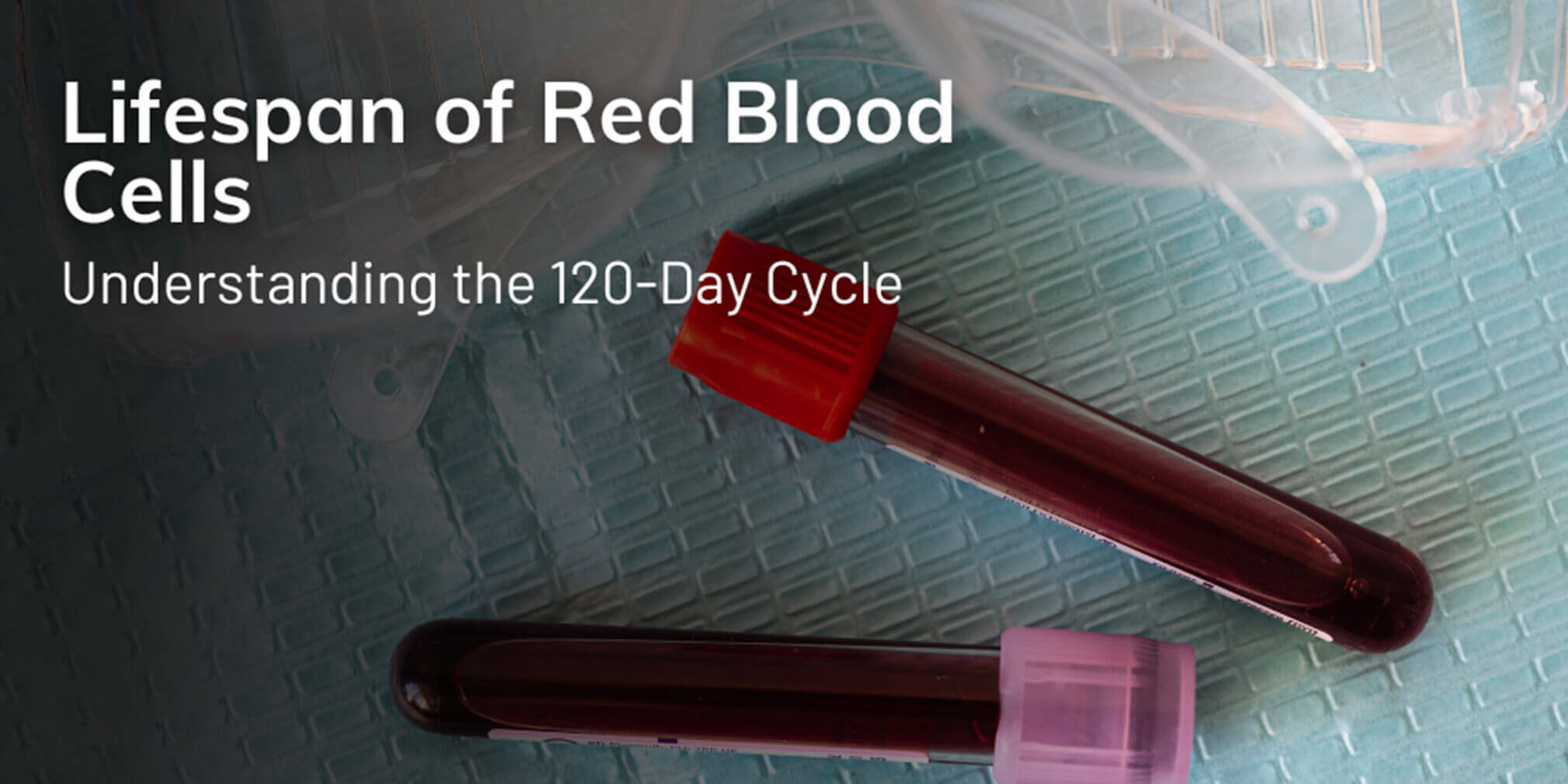
Lifespan of Red Blood Cells: Understanding the 120-Day Cycle
The lifespan of red blood cells refers to the duration that these cells circulate in the peripheral blood after their release from the bone marrow. The lifespan of RBCs in healthy adults averages around 120 days with a range of around 70-140 days.
However, this equilibrium can be disrupted due to various pathological conditions. This leads to the destruction of these cells, which also reduces their lifespan. Measuring the lifespan of RBCs is valuable for understanding the following factors of these cells in circulation:
- Maturation.
- Survival.
- Clearance.
This provides insights into the mechanisms underlying anemia and helps evaluate the efficacy of anemia treatments.
Understanding the Life Cycle of Red Blood Cells
RBCs are also known as erythrocytes. They are responsible for carrying oxygen from the lungs to various tissues in the human body. Then they bring carbon dioxide back to the lungs. These cells are produced in the bone marrow.
A healthy RBC circulates in the bloodstream for a certain period. How long do red blood cells live? The average life of them is almost 120 days. After that, the cells become old and least flexible. It hence makes it difficult for them to navigate through narrow blood vessels.
Where are Red Blood Cells produced and destroyed?
The red blood cell destruction takes place in the spleen. How? Once the cells are old or damaged, they are removed from circulation. They are primarily broken down/destroyed in the spleen because it works as a filter for blood.
As blood flows through the spleen, its narrow capillaries trap the old and rigid RBCs. Macrophages are specialized cells present and abundant in the spleen, where they engulf and break down these trapped cells. The process is known as phagocytosis.
The spleen is the main organ where old cells are filtered and broken down. The liver also plays a role in removing aged or damaged blood cells from the blood. This works when the spleen has been removed.
Here are the organs that play a role in the lifespan of red blood cells:
- Bone Marrow: This is where the formation of red blood cells takes place. They are produced through a process known as erythropoiesis.
- Liver: This organ also contains macrophages, like the spleen (also known as Kupffer cells). They help break down the RBCs but only do so in the absence of the spleen.
- Pancreas: It produces digestive enzymes and hormones such as insulin and glucagon. It does not play a role in filtering and destroying RBCs.
- Spleen: It filters the blood and RBCs. In fact, it is the main area where the macrophages remove and destroy old or damaged cells to keep the blood healthy.
Factors Affecting the Lifespan of RBCs
A unique combination of environmental, genetic, and pathological factors influences the red blood cell life cycle and lifespan. They can either prolong or shorten the lifespan of these cells. This depends on their nature and severity.
The genetic disorders affecting the lifespan of these cells
There are genetic disorders that can significantly reduce the lifespan of RBCs. This usually results in anemia and other complications.
| Name of Condition | How it affects the lifespan of RBCs |
|---|---|
| Sickle Cell Disease | A condition characterized by abnormal hemoglobin, causing RBCs to have an abnormal shape and break down prematurely. |
| Thalassemia | A genetic disorder that affects hemoglobin production. It leads to anemia and reduced lifespan of RBCs. |
| Hereditary spherocytosis | A condition where RBCs are produced without a functional membrane skeleton. This causes the spleen to remove them prematurely. |
Impact of infections on the lifespan of RBCs
Infections can also affect the survival of these blood cells. Certain pathogens (malaria parasites, especially) can infect them and cause them to be prematurely removed from circulation. Sepsis and other infections can cause inflammation and oxidative stress. This can damage RBCs and reduce their lifespan.
Environmental Exposures and Their Impact on RBCs
Environmental exposures also affect the RBC lifespan. Exposure to certain toxins like arsenic or lead can damage these cells and cut down their lifespan significantly. Moreover, lifestyle factors like alcohol consumption and smoking can also damage RBCs.
What biological processes play a role in the aging of RBCs?
As RBCs age, they undergo a series of cellular-level changes that lead to their removal from circulation. It is important to understand these changes so we can appreciate the systems that help control and manage the lifespan of these cells.
Cellular changes happening during the aging of RBCs
RBCs undergo an array of cellular changes during aging. We will briefly examine them:
- Loss of membrane due to deformation: It makes RBCs less flexible and more prone to removal by the spleen.
- Changes in ion transport: Any changes in the ion transport mechanism lead to changes in the volume and density of these cells.
- Rise in Oxidative Stress: Accumulation of oxidative damage contributes to the aging of RBCs.
- Telomere Shortening: The shortening of telomeres (protective caps on chromosome ends) can lead to cellular aging.
The following equation represents these changes:
RBC aging = Loss of Deformability + Changes in ion transport + rise in oxidative stress + Telomere shortening.
The Mechanism of the Spleen in Removing RBCs
The spleen plays a key role in removing aged/damaged RBCs from the blood circulation. The process involves three key steps:
- RBCs are filtered via the spleen’s sinusoidal slits.
- The macrophages and other immune cells detect aged/Damaged cells.
- These cells are then covered and removed from circulation.
What role does the immune system play?
The immune system plays a key role in maintaining the health of these cells. Macrophages and other immune cells remove the aged/damaged ones from circulation. Additionally, it also produces antibodies against pathogens to keep these cells safe from infection.
Conclusion
Red blood cells have a lifespan of 120 days. Yet, these cells are responsible for keeping our body safe and helping transport oxygen to all organs via the bloodstream. Moreover, the spleen plays a role in filtering out aged and damaged cells to ensure strong ones are flowing in the stream.
